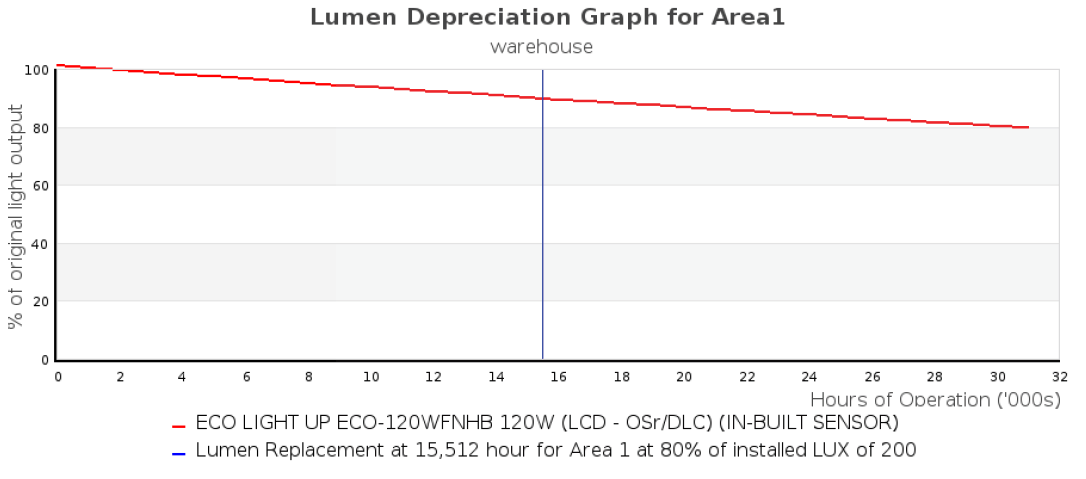Lamp Lumen Maintenance Factor (LLMF) Calculation
The lamp lumen maintenance factor is determined by using a method for projecting the lumen depreciation over the lifetime of the lamp made from LM-80 data using TM-21, which assumes an exponential decay after the first 1,000 hours of use. This form is expressed using the following equation:
Equation 1: Φ(t)= β exp(−αt)
Where
- Φ(t) is the normalized luminous flux output at time t and is equal to RMI/RLUX and also known as the Lamp Lumen Maintenance Factor (LLMF)
- RMI = Required Maintained Illuminance
- RLUX = Reported Lux
- β is a projected initial constant of normalized luminous flux
- α is the decay rate constant
A reference to this equation can be found here.
By using this equation, we can create a projection of lumen depreciation data that can then be plotted onto a chart with a y axis representing RMI/RLUX as a percentage of initial lumen output and the x axis representing time in thousands of hours.
Dirt Depreciation Factor (DDF) Calculation
Since the α (alpha) and β (beta) values from the LM-80 test data do not factor in other light loss factors (OLF) for the depreciation we use the OLF value calculated in the Maintained Illuminance Table to determine a Dirt Depreciation Factor(DDF). The DDF value also assumes an exponential decay over the life of the lamp and can be calculated using the following equation.
OLF = exp(DDF*RRP) which is equivalent to DDF = ln(OLF 1/RRP)
The extrapolation of the LM-80 data using the β and α values from the LM-80 test data and considering the OLF is then performed using equation 1 but with a modified decay constant (α) of
α = α – DDF
The resulting chart is then plotted.
Recommended Re-lamping Point (RRP) Calculation
The recommended re-lamping point (RRP) of the lamp is calculated using the following equation:
Equation 2: t = ln(B (RLUX/RMI)) / ( α – DDF )
This equation is equivalent to Equation 1 with the DDF considered and also with t representing the recommended re-lamping point.
Where
- t = recommended re-lamping point (RRP)
- DDF = dirt factor
- RMI is the Required Maintained Illuminance for the area based on table 3.1 of AS/NSZ 1680 1:2006
- RLUX is the average lux reading recorded after the installation
- B is a projected initial constant of normalized luminous flux
- α is the decay rate constant
Below is a proof to demonstrate that equations 1 and 2 are equivalent:
Using Equation 1,
Φ(t) = Be−αt
Where
- Φ(t) is the normalized luminous flux output at time t (this value is a percentage represented as a decimal between 0 to 1)_
- B is a projected initial constant of normalized luminous flux_
- α is the decay rate constant_
Φ(t) = RMI/RLUX
Where
- RMI is the Required Maintained Illuminance for the area based on table 3.1 of AS/NSZ 1680 1:2006
- RLUX is the average lux reading recorded after the installation
This gives
RMI/RLUX = Be−αt
Since e-αt= 1/eαt
RMI/RLUX =B / eαt
Invert both sides
RLUX/RMI =eαt / B
Multiple both sides by B
B (RLUX/RMI) =eαt
Since the natural logarithm function ln(x) is the inverse function of the exponential function exp we can say
αt = ln(B (RLUX/RMI))
Divide both sides by α
t = ln(B (RLUX/RMI)) / α
Factoring in the DDF we now have
t = ln(B (RLUX/RMI)) / ( α – DDF )
